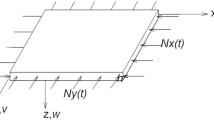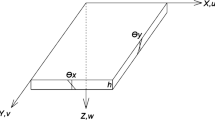Abstract
Purpose
This research proves a novel closed-form solution for the forced vibration analysis of a Mindlin viscoelastic plate subjected to harmonic transversal load and constant in-plane compression, simultaneously.
Method
The excitation frequency of the harmonic transversal load is considered as equal to the natural frequency of the viscoelastic plate. The viscoelastic properties obey the Boltzmann integral law with constant bulk modulus. The displacement field is approximated by the product of a known geometrical function and an unknown time function. The simple hp cloud method is employed for discretization. Calculating the natural and viscous damping frequencies, geometry, mass and stiffness matrices in the Laplace–Carson domain, and introducing the best values to replace the Laplace parameter, the dynamic responses of Mindlin viscoelastic plates are determined.
Results and Conclusion
The transient, steady-state and total dynamic responses of moderately thick viscoelastic plates are explicitly formulated in the time domain based on the elastic bending analysis at time zero, for the first time. In the numerical results, the effects of material properties and loading on the total dynamic responses are investigated.






Similar content being viewed by others
References
Wang Y, Tsai T (1988) Static and dynamic analysis of a viscoelastic plate by the finite element method. Appl Acoust 25:77–94. https://doi.org/10.1016/0003-682X(88)90017-5
Ilyasov MH, Akoz AY (2000) The vibration and dynamic stability of viscoelastic plates. Int J Eng Sci 38:695–714. https://doi.org/10.1016/S0020-7225(99)00060-9
Eshmatov BKh (2007) Nonlinear vibrations and dynamic stability of viscoelastic orthotropic rectangular plates. J Sound Vib 300:709–726. https://doi.org/10.1016/j.jsv.2006.08.024
Abdoun F, Azrar L, Potier-Ferry M (2009) Forced harmonic response of viscoelastic structures by an asymptotic. Comput Struct 87:91–100. https://doi.org/10.1016/j.compstruc.2008.08.006
Gupta AK, Khanna A, Kumar S, Kumar M, Gupta DV, Sharma P (2010) Vibration analysis of visco-elastic rectangular plate with thickness varies linearly in one and parabolically in other direction. Adv Stud Theor Phys 4(13):743–758. https://doi.org/10.4236/am.2010.12017
Li JJ, Cheng CJ (2010) Differential quadrature method for analyzing nonlinear dynamic characteristics of viscoelastic plates with shear effects. Nonlinear Dyn 61:57–70. https://doi.org/10.1007/s11071-009-9631-8
Shariyat M (2011) A double-superposition global–local theory for vibration and dynamic buckling analyses of viscoelastic composite/sandwich plates: a complex modulus approach. Arch Appl Mech 81:1253–1268. https://doi.org/10.1007/s00419-010-0483-y
Mahmoudkhani S, Haddadpour H, Navazi HM (2012) Free and forced random vibration analysis of sandwich plates with thick viscoelastic cores. J Vib Control 19(14):2223–2240. https://doi.org/10.1177/1077546312456229
Temel B, Sahan MF (2013) Transient analysis of orthotropic, viscoelastic thick plates in the Laplace domain. Eur J Mech A-Solids 37:96–105. https://doi.org/10.1016/j.euromechsol.2012.05.008
Amabili M (2016) Nonlinear vibration of viscoelastic rectangular plates. J Sound Vib 362:142–156. https://doi.org/10.1016/j.jsv.2015.09.035
Wan H, Li Y, Zheng L (2016) Vibration and damping analysis of a multilayered composite plate with a viscoelastic midlayer. Shock Vib. https://doi.org/10.1155/2016/6354915
Khadem Moshir S, Eipakchi H, Sohani F (2017) Free vibration behavior of viscoelastic annular plates using first order shear deformation theory. Struct Eng Mech 62(5):607–618. https://doi.org/10.12989/sem.2017.62.5.607
Amabili M (2018) Nonlinear damping in nonlinear vibrations of rectangular plates: derivation from viscoelasticity and experimental validation. J Mech Phys Solids 118:275–292. https://doi.org/10.1016/j.jmps.2018.06.004
Balasubramanian P, Ferrari G, Amabili M (2018) Identification of the viscoelastic response and nonlinear damping of a rubber plate in nonlinear vibration regime. Mech Syst Signal Process 111:376–398. https://doi.org/10.1016/j.ymssp.2018.03.061
Zhou YF, Wang ZM (2019) Dynamic instability of axially moving viscoelastic plate. Eur J Mech A-Solids 73:1–10. https://doi.org/10.1016/j.euromechsol.2018.06.009
Rouzegar J, Davoudi M (2020) Forced vibration of smart laminated viscoelastic plates by RPT finite element approach. Acta Mech Sin 36(4):933–949. https://doi.org/10.1007/s10409-020-00964-1
Silva VA, De Lima AMG, Ribeiro LP, Da Silva AR (2020) Uncertainty propagation and numerical evaluation of viscoelastic sandwich plates having nonlinear behavior. J Vib Control 26:447–458. https://doi.org/10.1177/1077546319889816
Sofiyev AH, Zerin Z, Kuruoglu N (2020) Dynamic behavior of FGM viscoelastic plates resting on elastic foundations. Acta Mech 231:1–17. https://doi.org/10.1007/s00707-019-02502-y
Ojha RK, Dwivedy SK (2020) Dynamic analysis of a three-layered sandwich plate with composite layers and leptadenia pyrotechnica rheological elastomer-based viscoelastic core. J Vib Eng Technol 8:541–553. https://doi.org/10.1007/s42417-019-00129-w
Amabili M, Balasubramanian P, Ferrari G (2020) Nonlinear vibrations and damping of fractional viscoelastic rectangular plates. Nonlinear Dyn 103:3581–3609. https://doi.org/10.1007/s11071-020-05892-0
Zamani HA (2020) Free vibration of viscoelastic foam plates based on single-term Bubnov-Galerkin, least squares, and point collocation methods. Mech Time-Depend Mater 25:495–512. https://doi.org/10.1007/s11043-020-09456-y
Jafari N, Azhari M (2021) Free vibration analysis of viscoelastic plates with simultaneous calculation of natural frequency and viscous damping. Math Comput Simul 185:646–659. https://doi.org/10.1016/j.matcom.2021.01.019
Jafari N (2022)Non-Harmonic resonance of viscoelastic structures subjected to time-dependent decreasing exponential transversal distributed loads, Earthq Eng Eng Vib, in Press.
Jafari N, Azhari M (2022) Dynamic stability analysis of Mindlin viscoelastic plates subjected to constant and harmonic in-plane compressions based on free vibration analysis of elastic plates. Acta Mech. https://doi.org/10.1007/s00707-022-03215-5
Amabili M (2018) Nonlinear Mechanics of Shells and Plates: Composite, Soft and Biological Materials. Cambridge University Press, Cambridge
Zhang NH, Cheng CJ (1998) Nonlinear mathematical model of viscoelastic thin plates with its applications. Comput Methods Appl Mech Eng 16(5):307–319. https://doi.org/10.1016/S0045-7825(98)00039-5
Jafari N, Azhari M (2017) Stability analysis of arbitrarily shaped moderately thick viscoelastic plates using Laplace-Carson transformation and a simple hp cloud method. Mech Time-Depend Mater 21(3):365–381. https://doi.org/10.1007/s11043-016-9334-8
Szyszkowski W, Glockner PG (1985) The stability of viscoelastic perfect column: a dynamic approach. Int J Solids Struct 21(6):545–559. https://doi.org/10.1016/0020-7683(85)90014-9
Author information
Authors and Affiliations
Corresponding author
Ethics declarations
Conflict of interest
The authors declare that they have no conflict of interest.
Additional information
Publisher's Note
Springer Nature remains neutral with regard to jurisdictional claims in published maps and institutional affiliations.
Appendices
Appendix 1
Forced Vibration Analysis of Simply Supported Bernoulli Viscoelastic Beams Subjected to Harmonic Transversal Load and Axial Compression
The equation of a Bernoulli viscoelastic beam subjected to a harmonic transversal load and axial compression, (as illustrated in Fig.
7) can be written as follows [28]:
in which \(M\) is the bending moment, \(w\) is the transversal deflection, \(t\) is the time and \(\rho \) is the mass per unit length.
The bending moment can be expressed as:
The stress–strain relation of a linear viscoelasticity based on the Boltzmann integral can be defined as [26]:
where \(E\left(t\right)\) is the modulus of elasticity.
For Bernoulli beams, the strain–deflection relation can be written as:
Investigating simply supported boundary conditions, the deflection may be approximated using the separation of variables method as follows:
It is noted that only one term of the series of \(\mathrm{sin}\frac{n\pi x}{l}\) has been considered, since the goal of this step is to concentrate on the time domain solution.
The time-dependent elasticity modulus can be expressed as:
in which \(\eta \left(t\right)\) is the relaxation function of viscoelastic material which is defined in Eq. (9).
Substituting Eqs. (66–70) into Eq. (65), Eq. (71) is obtained:
where \(I={\int }_{A}{z}^{2}dA\) is the moment of inertia.
The compressive load may be given as:
in which \({\alpha }_{1}\) is constant.
For Bernoulli viscoelastic plates, \(\Omega \) is defined as the fundamental natural frequency calculated by the free vibration analysis of Bernoulli viscoelastic beams at time zero, \({\Omega }^{2}=\frac{{E}_{0}I{\pi }^{4}}{m{l}^{4}}\). If the beam is subjected to axial compression too, the natural frequency is decreased \({\omega }_{0}=\Omega \sqrt{1-{\alpha }_{1}}\), [24]. In this paper, the beam is subjected to harmonic transversal load \(q\left(t\right)=q\mathrm{sin}{\omega }_{0}t\) and axial compression, simultaneously. In other word, the excitation frequency is equal to the natural frequency and the time-dependent behavior of the viscoelastic beam is studied.
Replacing Eq. (72) in Eq. (71), Eq. (73) is obtained:
Equation (73) can be simplified as follows:
in which \({\eta }^{*}\), \({F}^{*}\), \({\ddot{F}}^{*}\) and \({\left(\mathrm{sin}{\omega }_{0}t\right)}^{*}\) are the Laplace transformation of \(\eta \left(t\right)\), \(F\left(t\right)\), \(\ddot{F}(t)\) and \(\mathrm{sin}{\omega }_{0}t\), respectively.
For the steady-state response, the time function is approximated as follows:
Hence, Eqs. (76–77) are derived:
Inserting Eq. (77) into Eq. (74), Eq. (78) is obtained:
Equation (78) can be simplified as follows:
On the other hand:
Supposing \({c}_{1}+{c}_{2}=1\) and by substituting Eqs. (80) into Eq. (79), Eq. (81) is derived:
or
If Eq. (82) is solved by unifying the sentences:
Therefore, the steady-state response of a Bernoulli viscoelastic beam can be expressed as follows
But, if Eq. (82) is solved numerically:
Although Eq. (87) is hold \(\forall s>0\), the numerical solution showed that selecting the large value for \(s\), decreases the accuracy. And selecting \(s\approx \lambda \) is the proper selection.
On the other hand, the transient response of a Bernoulli viscoelastic beam can be expressed as follows [24]:
Thus, the total dynamic response can be written as:
\(C\) and \(D\) can be calculated using the initial conditions at time zero:
In other words, the transient response can be written as:
Finally, the total dynamic response of Bernoulli viscoelastic plates subjected to harmonic transversal load \(q\left(t\right)=q\mathrm{sin}{\omega }_{0}t\) and axial compression \(p={\alpha }_{1}{P}_{e}\) can be expressed as:
Appendix 2
Constructing the Simple hp Cloud Approximation Functions
Considering a selected set of scattered nodes as illustrated in Fig.
8:
Each node is centered at \({\mathbf{x}}_{i}\), related to the elliptical cloud \({\varphi }_{i}\) and has the effective radius \({h}_{ix}\) and \({h}_{iy}.\)
The basis functions, the simple hp cloud meshless approximation functions, are defined as:
where \({\psi }_{i}\) are the Shepard functions and \({\mathbf{L}}_{{\varvec{i}}}\) are the complete polynomial of order 2 as follows:
By defining the weight functions as:
Shepard functions are calculated in the following form:
Rights and permissions
Springer Nature or its licensor holds exclusive rights to this article under a publishing agreement with the author(s) or other rightsholder(s); author self-archiving of the accepted manuscript version of this article is solely governed by the terms of such publishing agreement and applicable law.
About this article
Cite this article
Jafari, N. Transient, Steady-State and Total Dynamic Responses of Mindlin Viscoelastic Plates Subjected to Harmonic Transversal Load and In-Plane Compression. J. Vib. Eng. Technol. 11, 1393–1405 (2023). https://doi.org/10.1007/s42417-022-00646-1
Received:
Revised:
Accepted:
Published:
Issue Date:
DOI: https://doi.org/10.1007/s42417-022-00646-1






